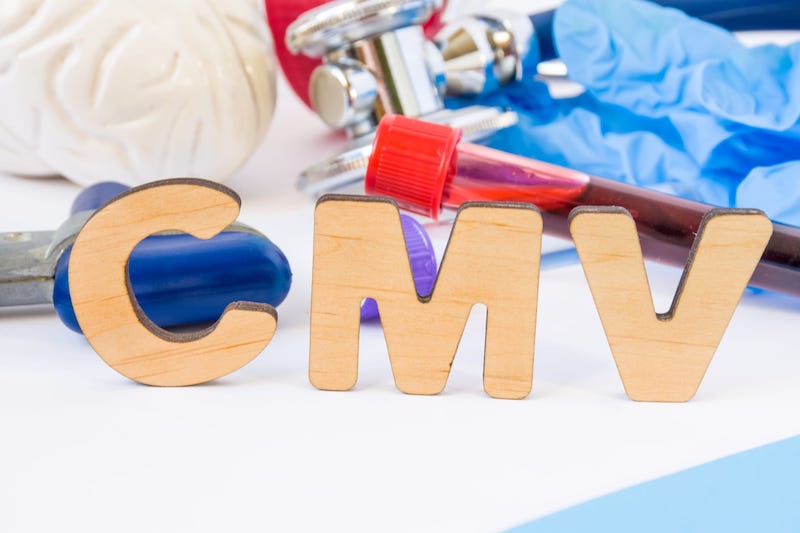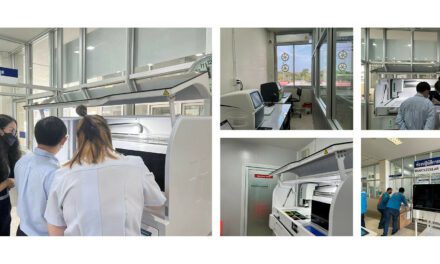With a lack of knowledge by both parents and healthcare providers about the risk of congenital CMV, better education and access to laboratory tests are needed to improve early diagnosis and treatment.
By Frances C. Esteve (AW)
Even though congenital cytomegalovirus (cCMV) is the leading cause of non-genetic deafness in children and has the highest incidence among common congenital conditions, only 7% of Americans are aware of its existence1. The unfortunate truth is that there is a lack of knowledge about congenital CMV among both parents and healthcare providers.
This lack of knowledge is concerning and highlights the need for population-wide awareness and education programs that focus on not just on parents and expecting parents, but also healthcare providers involved with the care of babies with a congenital CMV infection. Such programs would help to increase understanding of the disease, the treatments available, and would ensure that parents and healthcare providers are better informed to make decisions about diagnosis and care. The ultimate goal is to improve congenital CMV (early) diagnosis.
Parents Input for Congenital CMV Screening
Recent studies have shown that the vast majority, if not all, of parents are in favor of newborn congenital CMV screening and knowing the outcome. A 2017 survey of 726 women conducted at the state fair in Minnesota revealed an overwhelming majority of respondents in favor of newborn CMV screening. Of those surveyed, 96.1% “somewhat agreed” to “strongly agreed” that it should be offered. When asked if they would choose for a baby to be screened, 82% said “yes.” One of the survey results was interesting. It was found that women without children had the same level of knowledge about congenital CMV as mothers. This finding suggests that there is a need to provide more information about the virus to women of all ages, and not just those who are already mothers. Curiously, when women were given basic information about congenital CMV, they became significantly more interested in prenatal and newborn screening2.
A long-term qualitative study on family perception of newborn screening for congenital CMV showed that parents whose children were identified as being positive for congenital CMV through screening, found the medical advice they received helpful and empowering. They valued not only the screening but the follow-up assessments. The study included three groups of cCMV-positive babies: asymptomatic, asymptomatic with sequelae, and symptomatic. These three groups were followed for a mean of 22 years. All parent groups emphasized that appropriate education, support, and follow-up are crucial.
Parents of children who always remained asymptomatic also strongly supported newborn congenital CMV screening. Knowing their child’s cCMV-positive status at birth helped them know what to monitor, whom to consult, what to read, and where to look for solutions to current or potential problems3.
In a different survey, input from parents and healthcare providers was included as part of a study examining the implementation and impact of universal screening using saliva samples. The survey revealed that none of the parents refused to screen, and healthcare providers considered saliva-based screening “easy and quick”. While performing universal screening, the study detected 62% of the congenital CMV cases that otherwise would have been missed. These positive cases had no prenatal or neonatal signs of cCMV or maternal history of CMV infection during pregnancy. The congenital CMV cases that were expected or suspected due to maternal primary CMV infection and/or antenatal or neonatal signs accounted for 38% of the cases4.
These studies demonstrate that most parents favor testing newborns even without knowledge and find value in knowing the outcome.
Healthcare Providers Knowledge of Congenital CMV
Gaps in knowledge and practices can be associated with decreased testing levels, leading to missed opportunities to diagnose and treat congenital CMV in a timely manner. Recent surveys highlight the need for professional organizations to improve the requirements related to congenital CMV clinical training and education, guidelines, diagnosis, and testing requirements.
The outcome of a recent survey that included 103 primary care physicians and newborn hospitalists pediatricians in Michigan demonstrated insufficient knowledge of the neonatal presentation of congenital CMV and its sequelae and had lower levels of comfort in caring for infants with congenital CMV, with mixed knowledge of screening and testing standards. Some of the most salient findings of the survey include the following points: 60.2% are not comfortable in diagnosing and managing cCMV in their practice, 68% do not routinely test for cCMV, 76.7% are unaware of the prevalence of cCMV, 61% did not know the time frame for testing, and 59.2% rarely or never refer a baby for cCMV testing after failing their newborn hearing screen5.
A survey of 14 different institutions in the United States, including 32 pediatric infectious diseases (PID) physicians, revealed that 34.4% of the institutions had no early neonatal congenital CMV screening or testing protocol, even though there are recommendations and studies outlining the benefits from early detection of infection. Although there was a high level of knowledge among the pediatric infectious disease physicians related to signs and symptoms of cCMV, there was a lower level of knowledge related to understanding disease progression related to hearing loss. On the other hand, when asked about their practice regardless of institutional protocol, many advocated for greater screening and testing. Of the participating physicians, 78% personally ordered testing for cCMV in newborns with diagnosed sensorineural hearing loss (SNHL). Still, 9.4% of the physicians surveyed did not test or screen for congenital CMV in their practice. Overall, the responses indicate that there is a relatively high level of institutions that have not implemented congenital CMV testing or screening6.
Understanding why Congenital CMV Testing is Lacking
The lack of testing is in part because congenital CMV programs have yet to be widely implemented in the United States, leaving healthcare providers to rely on clinical suspicion alone to prompt testing.
A study evaluating clinically asymptomatic cCMV-positive babies found that 56% of newborns with a normal physical exam could be reclassified as “symptomatic” after further evaluation revealed at least one abnormality (i.e., 45% abnormal neuroimaging, 21% sensorineural hearing loss (SNHL), 16% thrombocytopenia). Recognition of abnormalities may identify neonates who could benefit from antiviral therapy. The study’s outcome emphasizes the need for universal screening of newborns since late-onset hearing loss can occur in an additional 15-25% of CMV-infected infants7.
Hospitals are not consistently testing for congenital CMV, as shown by the Massachusetts Congenital CMV Coalition, established in 2019. To assess the state of neonatal CMV screening, they designed a survey for all birthing hospitals in Massachusetts (Nov 2020 – Feb 2021). Of the 73.3% of hospitals that responded to the survey, only 48.5% (16 out of 33 respondents) had an established approach for neonatal congenital CMV screening. However only 9 out of 16 respondents reported having an approved written protocol. Saliva-based nucleic acid amplification test (NAAT) was the most common testing modality. Testing after failing the newborn hearing screen was the most common approach to cCMV screening (93.8% of hospitals), with one hospital screening all babies admitted to the nursery and two hospitals testing all babies admitted to the newborn intensive care unit (NICU). 36.4% of the respondents reported having providers who performed screening without a written protocol. The results highlight a deficiency in standardized testing and inconsistent congenital CMV screening practices8.
A retrospective review of electronic health records for eligible babies, including 40,091 births, revealed that only 178 were tested for congenital CMV, and ten infants were diagnosed with congenital CMV. The diagnostic prevalence was 0.2 cases per 1000 infants, 15-fold lower than the expected prevalence. The prevalence of asymptomatic cases was 81-fold lower than expected and 2-fold lower for symptomatic cases. The findings show that 72% of babies tested came from the NICU. Yet, the NICU had a positivity rate of 2.3% compared to 27.6% of positives, which came from providers in non-NICU settings and 7.7% positives from newborn nurseries and pediatric general care. Even though congenital CMV is the number one cause of non-genetic deafness in children, the study showed that only 1% of the babies that failed their newborn hearing screen were tested for cCMV, and of these, 16.7% tested positive for cCMV9.
Once again, the data points to the need for education and awareness, especially in areas outside of the NICU, and for implementing testing protocols for cCMV that would help with more consistent testing practices, given the missed opportunities for early diagnosis and treatment.
Impact of Legislation on Testing
Ten years ago, Utah became the first state to pass legislation for congenital CMV testing. Today there are 18 states with legislation in effect, but only 11 states require either testing and education or testing only for congenital CMV10. The other states only require education for the public and professionals. Of the 11 states, Minnesota is the only one that requires screening of all newborns (universal testing). In contrast, the other states require testing after a baby fails their newborn hearing screen (targeted testing). In the last couple of years, we have seen a significant increase in states that have passed legislation and in states that have proposed legislation awaiting approval. Let us hope that the trend continues, and legislation approvals move faster than in the past 10 years.
Having legislation in place brings awareness and helps drive testing compliance. However, for the implementation of routine testing to be successful, it must also be accompanied by a multidisciplinary approach that includes education and training in all areas involved. Something as simple as sample collection is as important as the test itself, which means that all areas play a vital role in the success of testing for congenital CMV.
Equally important is what needs to happen after a positive result. Under ideal circumstances, the result is obtained from the laboratory before the baby is discharged from the hospital, providing the opportunity, if necessary, for prompt treatment, additional testing, and/or referral to other areas that can positively impact the outcome of the baby and provide support for the parents.
In recent years testing for congenital CMV has become simpler, easier, and more accessible. The availability of FDA-cleared tests for congenital CMV has paved the way to bringing molecular testing closer to the patient. They allow institutions to run the test on-site instead of sending it out, which usually takes 2-4 days to get results. Being able to run the test on-site not only can be more cost-effective, but it can provide same-day results that can avoid delays in discharge. Regardless of the testing approach, a key factor remains, there is no way to tell with 100% certainty that transmission occurred unless the newborn is tested within 21 days of birth. With a rapid molecular test like Alethia CMV from Meridian Bioscience11, physicians and parents can have actionable results before the baby goes home.
Congenital CMV diagnosis is lagging as studies have demonstrated, so establishing an organized strategy that includes standardized education of healthcare providers and testing guidelines must occur. Ultimately, enacting these measures aims to improve early diagnosis of congenital CMV in newborns and provide overall better patient care that impacts their quality of life and their future.
About the Author

With more than 40 years of experience in IVD at Meridian Bioscience, Frances C. Esteve is currently a marketing product manager. During her tenure with the company, she has held various positions in the areas of product research and development, manufacturing, international sales, and marketing. In addition, she has. served as an ASQC Certified Quality Auditor.
References
- Sara M. Doutre, et al. Losing Ground: Awareness of Congenital Cytomegalovirus in the United States. The Journal of Early Hearing Detection and Intervention, 2016; 1(2): 39-48.
- Katie J Tastad, et al. Awareness of congenital cytomegalovirus and acceptance of maternal and newborn screening. PLoS ONE, 2019; 14(8):e0221725.
- Michael J. Cannon, et al. Family Perception of Newborns Cytomegalovirus Screening: A Qualitative Study. International Journal of Neonatal Screening, 2021; 7(8):2-13.
- E. Letamendia-Richard, et al. Universal newborn screening for congenital cytomegalovirus infection: feasibility and relevance in a French type-III maternity cohort. BJOG, 2021; doi:10.1111/1471-05.
- Megan H. Pesch and Kathleen M. Muldoon. Congenital Cytomegalovirus Knowledge, Practices, and Beliefs Among Primary Care Physicians and Newborn Hospitalists. J of Primary Care & Community Health, 2022; Vol 13:1-7.
- Chieko Hoki, et al. A cross-Sectional Survey of Pediatrics Infectious Disease Physicians’ Approach to Congenital Cytomegalovirus Infection. International Journal of Neonatal Screening, 2023; 9(17):1-13.
- Andrea Ronchi, et al. Evaluation of clinically asymptomatic high risk infants with congenital cytomegalovirus infection. J of Perinatology, 2020; 40:89-96.
- Cheryl K. Glovsky, et al. Congenital Cytomegalovirus Screening in Massachusetts Birth Hospitals: A Statewide Survey. International Journal of Neonatal Screening, 2022; 8(65):1-10.
- Kate L. Wilson, et al. Inconsistent Provider Testing Practices for Congenital Cytomegalovirus: Missed Diagnoses and Missed Opportunities. International Journal of Neonatal Screening, 2022; 8(60):1-13.
- National CMV Foundation. https://www.nationalcmv.org/about-us/advocacy
- Meridian Bioscience, Inc. https://www.meridianbioscience.com/diagnostics/disease-areas/pediatric-neonatal/cmv/?country=US





